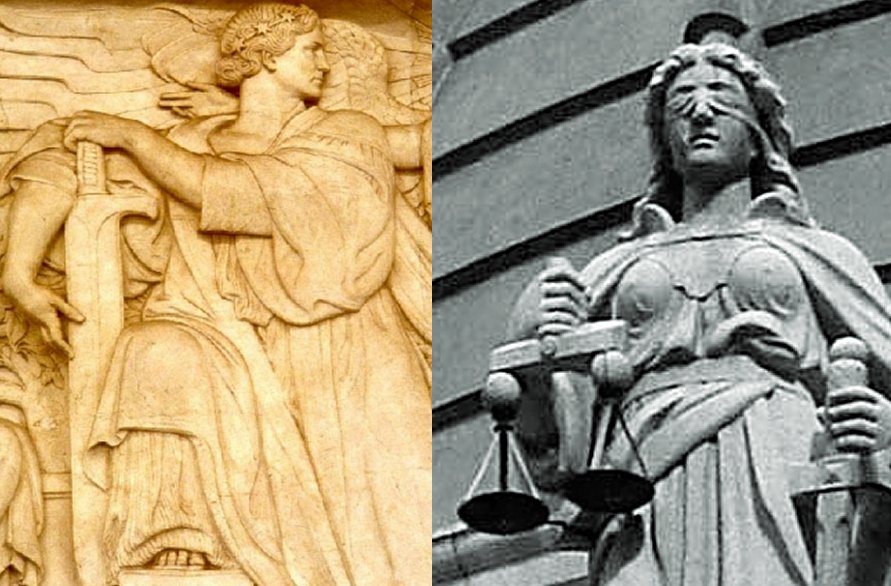A. Sutherland - AncientPages.com - We call her today - Lady Justice. Her modern statues frequently decorate courthouses and courtrooms in many countries worldwide.
Additionally, images of Justice can be found virtually anywhere. They appear on sculptures, bas-reliefs, statues, paintings, porcelain, stained glass, seals, coins, sometimes on medals, logos of certain websites, and even on clothes.

In the past, creating an image of Justice was not easy. Many artists seemingly asked themselves simple questions: How to paint Justice? What does she look like?
After all, Justice is an idea, a specific legal and philosophical concept, which means that artists could not use the model of Justice; they could only create their own impression of her.
In ancient Rome, she was called Iustitia (Justitia). In Greece, she was equal to the goddesses Themis ("the Lady of good counsel") and the personification of law, divine order, divine Justice, natural law, right, fairness, and custom), and Dike (the goddess of human Justice and the spirit of moral order and fair judgment).
It was long believed that in the Golden Age, she lived on Earth, and then, with the rise of human wickedness, she left the planet and went to the sky to dwell in the constellation of Virgo.
Long Tradition Of Lady Justice
Her prototype was the Egyptian goddess Maat Ma'at (Mayet), symbolizing and personifying the ancient Egyptian concepts of order, Justice, harmony, law, truth, balance, and morality.
In Egypt, the idea of law, divine order, and truth were personified by the goddess Ma'at, presented as a young woman holding a set of scales in one hand and a symbol of eternal life - the sign of Ankh.
Appearance, Attributes And Their Meaning
As depicted on the statues, Lady Justice has a long robe/dress, a sword, and the scales of Justice and is usually (but not always) wearing a blindfold.
These attributes are of great importance due to their symbolism. Carrying a double-edged sword in her right hand, Lady Justice wants to emphasize the power of reason and Justice, which can be used for or against an individual.
The sword in the hand of the Lady of Justice means even more. It symbolizes authority exercised by emperors, kings, and other influential individuals. It can also be used against a king or ruler's power and cease it in the blink of an eye.
Blindfold Justice - Obliged To Be Objective
The blindfold represents objectivity with no place for prejudice or passion.
Therefore, the Lady of Justice must act objectively and without favor or fear. Her decisions must be weighed on the scales and done without regard for a person's identity, power or weakness, money, or rank.
However, the earliest Roman coins depicted Justitia with her eyes uncovered.
One argument for Justitia's naked eyes was to urge judges to consider cases with their open eyes.
One example is the statue of the Lady of Justice - without a blindfold - atop the Old Bailey courthouse in London. Later, since the end of the fifteenth century, she was commonly represented as "blind."
The Scales Will Decide About A Verdict
A set of scales has a long history. It was placed before the temple to weigh the deeds of the deceased. Nemesis, a winged goddess of Justice and revenge, is portrayed with a set of scales and a sword. Also, Atropos, one of the Moirai, was occasionally depicted with a pair of scales. In the Book of the Dead, Anubis, the "Guardian of the Scales," participates in the Weighing of the Heart ceremony.
He measures to determine whether the person is worthy of entering Duat (the realm of the dead).
Lady of Justice holds a set of scales in her left hand because she measures the strength of a case's support and opposition.
The scales in her hand will decide a verdict.
Lady Justice Represents One Of Four Virtues
Christianity's four classic cardinal virtues symbolize temperance, courage, prudence, and Justice.
In ancient Roma, Justice (Iustitia) was celebrated by Augustus, a Roman statesman and military leader who became the first emperor of the Roman Empire, reigning from 27 BC until he died in AD 14. A few years later, emperor Tiberius ordered the building of a temple of Iustitia in Rome on 8 January 13 BC.
From then on, justice (Iustitia) became a symbol of justice, and every Roman emperor associated his rule with it.
Written by – A. Sutherland - AncientPages.com Senior Staff Writer
Updated on September 3, 2024
Copyright © AncientPages.com All rights reserved. This material may not be published, broadcast, rewritten or redistributed in whole or part without the express written permission of AncientPages.com
Expand for referencesReferences:
Berger A. Encyclopedic Dictionary of Roman Law
Tremblay Luc B. The Rule of Law, Justice, and Interpretation






